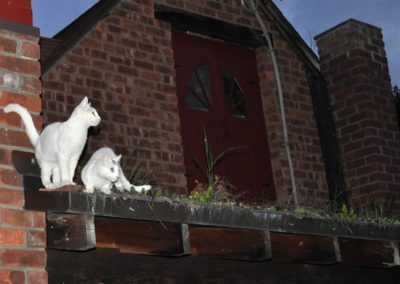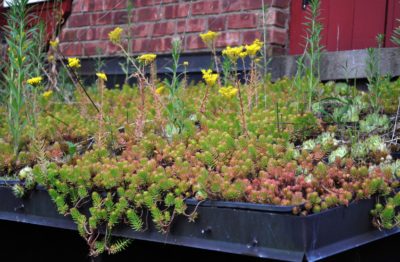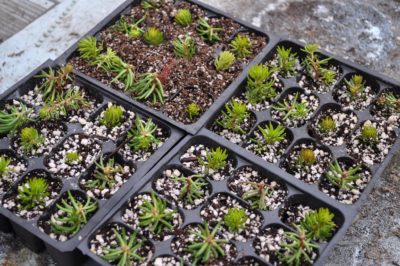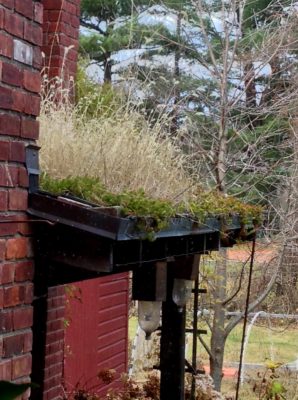CATS ON A COOL, GREEN ROOF
Not Green Enough
I’m looking up at my green roof, my evergreen roof, and it’s not green enough. Literally. I had expected that by now the roof would be solid green. It’s not.
The green of this roof was supposed to come from the plants growing on it. Because conditions up on the roof are very harsh, the plants I chose were tough ones, hens-and-chicks (Sempervivum spp.). Hens-and-chicks look like little cabbage heads of stubby, succulent leaves. Baby plants push out from around the mother plants, grow, and make more babies, and so on, ad infinitum. Or so I hoped.
The roof only has a couple of inches of “soil” on it and covers a porch, so has no heated space or insulation beneath it. If winter temperatures plummet to 10 degrees below zero, not uncommon here, temperatures within that thin layer of soil also plummet to 10 degrees below zero. If summer temperatures hit 95° in the shade, the soil, which is shaded at one end, also hits 95° — and more in the sunny end. The roof never gets watered, except by natural rainfall.
The hens-and-chicks have established and survived and spread. But not enough. By now, I expected the roof be packed solid with hens-and-chicks, with excess plants spilling decoratively over the front edge. But too much soil still shows. Part of the green problem is that hens-and-chicks are not all that green; the leaves are more pale blue-gray.
Enter Angelina
So I’ve been taking steps to green up the roof.
The first step has been introducing a companion plant for the hens-and-chicks. The plant, which I believe is ‘Angelina’ rocky stonecrop (Sedum rupestre), has been magically appearing here and there in and around my rock walls. Well, not magically. As with other succulents, ‘Angelina’ easily grows into whole new plants wherever any piece of stem or leaf merely drops onto the soil. Over the past few years, whenever I’m so inclined, I grab a few pieces of ‘Angelina’ and toss them up on the roof. They’ve rooted and spread, parading up there as forest-green patches.
I periodically get more serious with ‘Angelina’. “More serious” means filling some cell-type seedling flats with a “soil” of equal parts moist peat and perlite, and poking inch-long pieces of leafy ‘Angelina’ stems into the mix. After a winter in the greenhouse or a sunny window, those cuttings are rooted enough to plug into holes I dibble into the soil on the roof among the hens-and-chicks. The roof is a little more than 100 square feet. Each plant could potentially fill up a square foot in a couple of seasons, so 100 cuttings of this plant would do the trick and take up only a couple of square feet of space in their holding cells.
Another step to making the rooftop greener is to beef up the “soil.” The soil is actually a mix of equal parts peat and calcined montmorillonite clay (a.k.a. kitty litter, unused). The mix is heavy enough not to blow away, and the peat is relatively resistant to decomposition. Some shovelfuls of this mix periodically tossed up on the roof replace what’s washed away or settled.
The mix is lean in nutrients so, come spring, I could also beef up the rooftop with some fertilizer. Not much, though, because succulents are light feeders and too much fertility would encourage weeds.
Is Green Better Than . . . ?
I don’t get it. Green roofs are so “in” these days, for their green appearance and for their environmental green-ness. Sure, green roofs insulate rooms below from heat and cold. And green roofs capture and evaporate some rainwater rather than let it run down gutter pipes and into sewers or streams. The air above green roofs stays cooler than that above conventional roofs, so heat islands aren’t created.
But are the above good enough reasons to put plants on a roof? After all, good insulation also insulates, a lot better than soil and with a lot less weight. And how much water could a roof of succulent plants — plants known for their low water usage — evaporate?
Much as I love plants, I’d rather see solar panels on roofs. My green roof is for looks (and not sunny enough for solar panels).
And A Bow To The Weeds
My green roof is a testimonial to the tenacity of plants. Despite the leanness of the soil mix and its being initially pretty much weed-free, some weeds have colonized the roof. And they survive, despite the harsh growing conditions up there.
The weeds that came in weren’t succulents, but grasses and perennials such as foxtail grass and goldenrod. Every time I look up at the roof, I am awed at how these and other plants not only got there, but how they manage to survive there year after year.
Weeding up there would seem such a travesty — and be very difficult.



I love it! (except the weeds). I’ve seen some tiny bird houses planted with green roofs – I think I’d start with that – small. I do admit that I would rather see solar panels on the roof, too! However, I think green roofs in heavily populated and structured cities would be more beneficial. I’m glad to see how tough hens and chicks are since I left mine in a cedar wood box up North – I’m hoping they’ll be there thriving come spring!
Native prairie plants can make excellent green roofs. Try little bluestem, buffalo grass, blue grama grass, and some prairie wildflowers like threadleaf coreopsis. Drought tolerant and accustomed to wind and (often) low fertility.
In my 2-inch-deep rooftop “soil”??!! Another downside to the plants that you mentioned is that they wouldn’t present any green in winter.